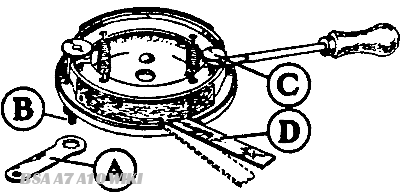BRAKE RELINING
Brake Shoe Removal and Replacement

Fig. M40. Removing the Brake Shoes
After the brake plate has been removed from the wheel, the brake cam lever A (Fig. M40) should be detached and the cam spindle B pushed in slightly to allow the shoes to dear the brake plate. Insert a screwdriver between the brake shoes at the fulcrum pin C and twist the screwdriver.
Place a small lever D between one of the shoes and the cover plate and lever the shoe away from the cover plate until the spring pressure is released. Both shoes can then be lifted from the brake plate.
The shoes can be replaced by the reverse procedure. Hook the springs on to the shoes and place the ends of the shoes in position on the fulcrum pin and cam lever. Then push the shoes outwards until the springs pull them into their correct position.
NOTE: The brake shoe springs are quite strong and care should be taken that the fingers are not trapped by the brake shoes during these operations.
Brake Shoe Relining

Fig. M41
With the shoes removed the linings can best be removed by drilling away the heads of the rivets and punching the shanks out to the inside of the shoe with a suitable drift.
New linings are die pressed to suit the curvature of the shoes, but[[Image:]] will require drilling and counter-boring for the rivets. Position the lining and hold it in place at one end by means of clamps. Using the holes in the shoes as guides, drill holes of the correct size for the rivets adjacent to the clamp. Turn the shoe over, and counterbore the holes just drilled sufficiently deep so that the rivet heads will stand below the lining surface; this is important, since the rivets will otherwise score the brake drum.
Insert the rivets into the holes and rivet them over on the inside of the shoe. This is easily accomplished by holding in a vice a short length of rod, whose diameter is equal to that of the rivet head, and using it as an anvil upon which to rest the rivet head while hammering the shank over. (See Fig. M41.) This will also make sure that the rivets do not stand proud of the lining.
Move the clamps to the next pair of holes, taking care that the lining is kept in firm contact with the shoe the whole time, and repeat the above procedure. When the lining is finally riveted down, bevel off the ends of the linings and file off any local high spots.
Precautions to be observed when fitting the relined shoes to the hubs are given in the Service Sheet on Hubs and Brakes.

